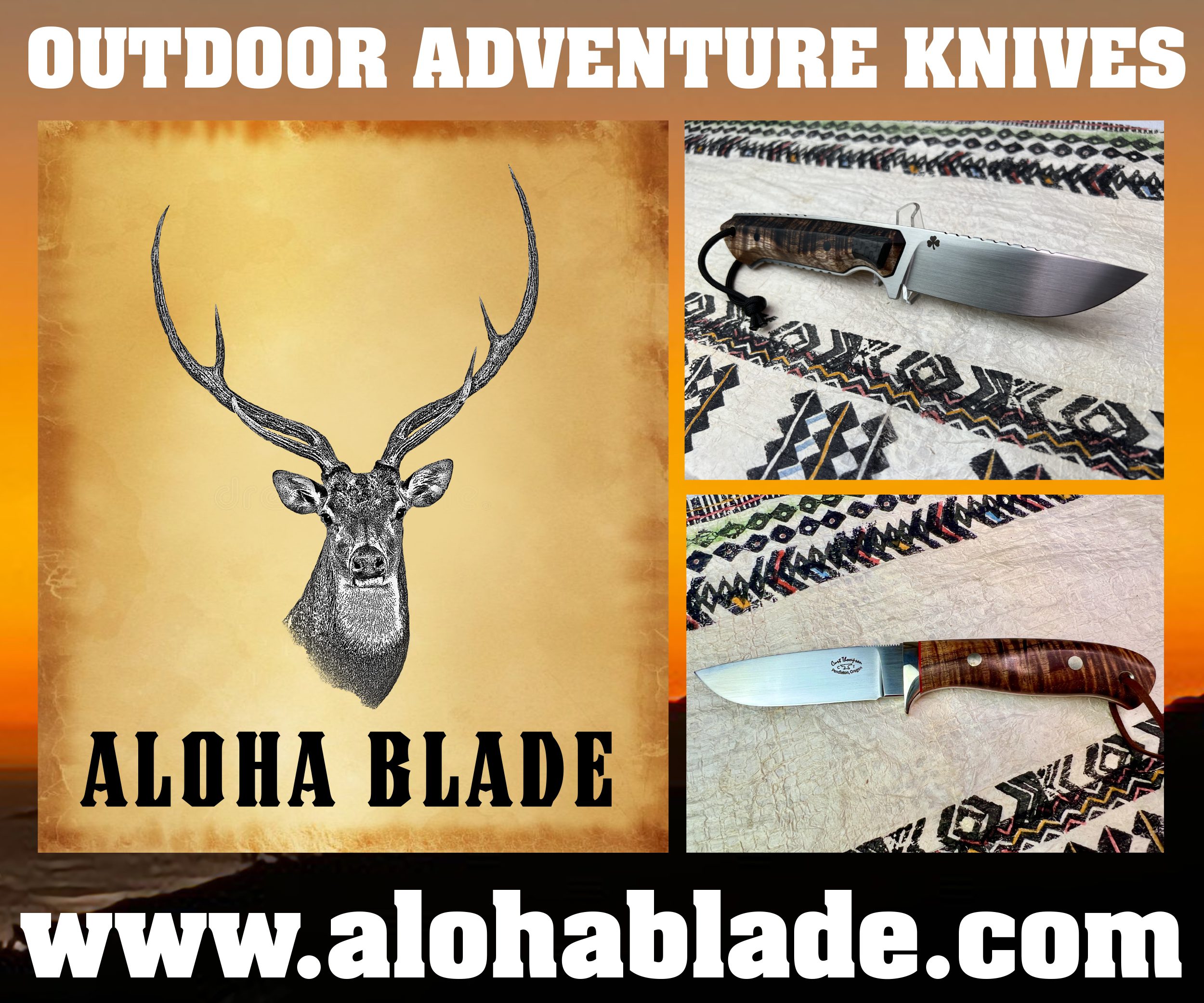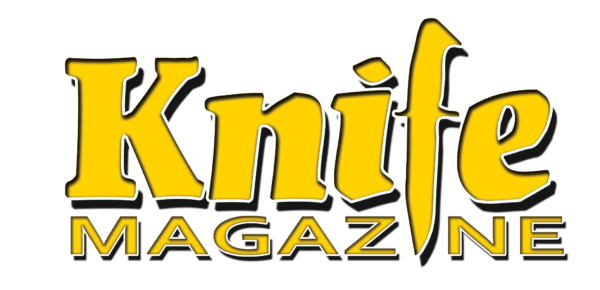Del Corsi is a knifemaker and Knife Magazine contributor from British Columbia. He is also an extremely personable fellow whom I look forward to meeting one day soon. He and Mark go way back.
KnifeKits.com and Jantz Supply both donated two kit knives a piece. Del assembled and finished one of each, and wrote about the experience in the July 2019 issue of Knife Magazine. Premium Online Members can see that entire issue, and our entire archives for that matter, by looking to the menu bar at the top of the page and selecting The Vault –> Magazine Archives. The rest of you are in luck though, you can see the entire article in flipbook format by clicking the image below. This will show the article as it appeared in print, with all of the photos and captions:
You can also scroll down and read the text of the article in its entirety.
I intended to do more of a write up myself, but I realized that there was little I have to add other than we also gave away an unfinished kit from each company.
A plunge-lock folder from KnifeKits.com:


and a Damascus Chefs Knife from Jantz Supply:


Either will be a fun project for the winner and yield a tool to be proud of.
Thursday and Friday, days 41 and 42 of our 100 Knives in 100 Days Giveaway we will be giving away the two finished knives, Jantz on 7/11 and KnifeKits on 7/12.
And now without further ado..
Build your own Kit Knife
By Del Corsi


For the hobbyist, hunter, or knife enthusiast, there is nothing quite like the feeling of making part or all of the knife that you will carry and use. Kit knives are readily available and manufactured with this in mind. They are produced in a multitude of designs and shapes to suit every need that requires a knife. Many knifemakers began their career by finishing these blades, it’s a terrific way to sample some of what is required before spending considerable funds on specialty knifemaking equipment.
For parents I can’t think of a better way to get youngsters away from the cell phones and electronics for a while. Supervision is a must, however what a great opportunity to introduce children to something that is an everyday tool while spending quality family time together? It provides a great platform to teach safety rules, respect for knives, all the while learning to work with their hands – it doesn’t get any better than that!
The two companies that provided kits are Jantz Supply and KnifeKits.com. Both sell knifemaking supplies and carry a wide range of quality knife kits, handle materials and other components. They also carry a great selection of DVDs and books on a multitude of knifemaking instruction and related subjects.
Tools Used:
120 grit to 1500 grit sandpaper sheets and discs, sanding blocks, coarse files, epoxy, assorted drill bits, step-drill, hacksaw, ball peen hammer and smooth tipped punch.
(Optional) belt sander, 5” disc sander, buffing machine, drill press, bandsaw.
There are many ways to do this type of work. The methods discussed and pictured here work well. You may have other methods to achieve the desired results, and whatever works is the right way for you. The goal is to enjoy the process and end up with a great tool to use.
Safety:
Before starting a project like this it is important to have safety in mind. Many people purchase expensive grinders and machinery, then spend little or nothing on safety equipment. Steel, abrasive products, buffing compounds, exotic woods, synthetic resins, pearl shell and other materials can seriously affect the lungs, eyes and skin. Wear a respirator and have adequate ventilation. Those cheap dust masks do little, allowing you to breathe the fine particulates that filter through! Always wear safety glasses or face shields. Keep some band-aids and a first aid kit handy for minor scrapes and such.
KnifeKits.com Tanto: Sensei Model #KK534BL
KnifeKits.com sent their sleek Tanto “Sensei” model with CNC machined Hybridwood scales, and a DDR3 “Button Lock Folder” for me to check out. Choosing which model to work on was a dilemma as the folder was very nice; however after handling the Tanto it instantly became my choice. The weight and feel was superb, and it fit my hand well too. Bottom line; this Tanto design is just very appealing!
KnifeKits.com has an incredible website, they are very knowledgeable and provide quality products and service. Founder Alex Whetsell shared a few words about the company’s desire to serve their friends and customers; “Helping fellow hobbyists make great stuff with their own hands has always been our main focus. Our goal from the beginning was to offer do-it-yourself components that could assist knife, gun, sheath and holster makers, even with basic skills, to rival the finest quality custom handmade items being offered by industry professionals. Many of today’s top name knife and holster makers attribute KnifeKits.com as the source of their inspiration and early learning.”
The blade I received had a nice satin finish, and a good sharp edge as well. My first step was to use masking tape to protect both the blade finish and my fingers while I handled the blade during different procedures in the finishing process. A felt tip pen is used to mark the top right and top left sides of the handle scales. The satin finished bolsters were pre-drilled so the first step was attaching them to the blade by peening the provided pins. A ball peen hammer peens the pins, then a punch with rounded end is used to finish peening the pins on each side. A hard surface for this process is necessary to support the work, the small shop anvil pictured works well for this purpose. So much for our nice shiny surface, but this will be easy to clean up.
Next, we drill our scales. 3/16” stainless steel pins were provided, the scales were clamped and drilled to fit the pins. The photos show how one side is drilled first, then both scales are clamped on using the first side as a pilot-guide for the second side. Remember to double check the felt pen markings and get the sides correct prior to drilling. I used to clamp side A first, then drill, remove, clamp side B and drill, but for some reason the fit was always off, causing problems. Don’t do it that way!
The next step is to epoxy our handle material to the tang. Each side was marked for the left and right scales, the pictures show that the taped side of the blade is marked with left and right as well. Trust me, this simple step saves some disappointment later! The bottom part of the handle material is roughed up on a flat surface using coarse sandpaper, a flat surface is necessary before we can glue the handles. Cracking could occur if the handle material is even slightly warped.
Clean the tang of your blade thoroughly before applying the epoxy, acetone works well to remove any grease, dirt, even the oil from our hands can be a problem. This ensures a good bond and strong joint especially when only using pins. I prefer epoxy with a cure time of 20 to 30 minutes, 5-minute epoxy just sets up too fast for me. The epoxy is applied to the tang and handle scales, clamps are applied, then left overnight. Never clamp too tight, this can squeeze out the glue-line resulting in a poor bond.
The next day, a hacksaw will quickly remove the extra length of pinning material. A small belt sander can be used for shaping the bolsters and scales, but files and sandpaper do the same job. Once again, safety is most important here. Abrasive grit from sandpaper or sanding belts is not something we want in our lungs, so too are many handle materials we use. Some people develop a rash from cocobolo, ironwood, and other materials. Fiberglass resins, fumes from the chemical reactions from epoxy being mixed, these are not healthy to breathe either. Use a good respirator and work in a ventilated area.
Using a shop vac to control dust, as many do, can be a bad idea. Fine particulates being exhausted from the canister stay and circulate in our work area. Even worse, sparks coming off the steel can combine with fine handle shavings and ignite inside the machine! In my shop a water bucket lies right beneath my grinder, catching the hot sparks while my exhaust hose sits far enough above to clean the fine airborne dust. Even with this I always wear a particulate respirator!
Once your handle shaping is finished, work your way through progressively finer grits of sandpaper, removing all scratches from the previous grit before moving on to the next finer grade. The entire surface of our handle and bolsters can be brought to a very nice finish using automotive sandpaper like the 1500 grit discs pictured. The ones I use are the hook and eye type, they fit on a disc machine that cost less than $20, [this includes the shaft, 5” Velcro disc, and a motor that I bought at a yard sale for $5.00.] Velcro strips are available that have a sticky back, these are then put on pieces of leather and wood to use for hand sanding. The hook and eye discs lock on the Velcro providing some great little sanding tools. It is not necessary to use machinery at all, but I did quickly buff the scales and bolsters on this knife. Sometimes a hand-rubbed finish looks even better; it depends on the knife and your preferences.
All in all this Tanto kit was awesome to work on, all that is needed now is a sheath or presentation case. Their website has everything you need in this respect. To order a similar kit or any of the numerous products they carry, check out their fantastic website at KnifeKits.com or call 1-877-25-KNIFE. You can also sign up online for their Newsletter featuring tips, specials and much more.
Jantz Supply Drop-Point: Model J2208, U.S.A. Made
For over 20 years I have ordered knife supplies from Jantz Supply. Owner Ken Jantz continues to advance and improve the products and services with the help of family and staff of this legendary company that began in 1966. They have a super catalog with a vast array of equipment and products for every aspect of knifemaking. Jantz Supply manufactures their own line of blades which includes the exquisite drop-point they provided along with some very cool pine cone scales for the handle. They also included a VG10 Damascus Hamal Chef’s knife. Another difficult choice on which model to make. I would have loved to try the kitchen knife and put it to work, but probably would have kept it for myself. In the end I chose the drop-point; who doesn’t love this design? The fact that this model is from the line of U.S.A. blades that Jantz manufactures made this too cool to pass up.
This 440C blade came with a uniform satin finish and a sharp edge. It is also available in D2 and damascus steel. Jantz supplied ¼” brass Corby bolts along with the appropriate step drill. Brass bolsters and pins were included for our project as well.
Once again the first step begins with safety. The pine cone scales are produced with actual cones embedded in dyed resin. They are very beautiful, however phenolic resins along with the abrasives we use during the shaping process are not great for our lungs. Various woods and other handle materials can cause reactions on the skin as well. Always work in a well-ventilated area, wear eye protection, a respirator designed for fine particulates, and latex gloves for your hands.
First, masking tape is applied to protect the blade and fingers during the handle and bolster steps. Then comes peening the bolster pins, which are 1/8” diameter in this case. The pictures show a large washer placed under the first pin being peened. This allows some room for the bottom pin between the washer, bolster bottom, and the hard surface of the anvil. This makes it easy to completely pound and secure the bolster on the top while keeping both bolsters tight to the tang. It is not unusual for the opposing bolster to spread apart during the hammering process, the washer prevents this by holding the bottom section tight to the tang. It also allows for the necessary thickness of pin to go through, making the next step a breeze. The second pin is done the same way. Now flip over and hammer the other side, again a punch with a rounded end drives the pins home.
The pine cone scales are now sanded flat on the side that will be against the tang, this is always done to ensure a true surface. If we clamp scales that are not flat to the flat tang, they would be prone to cracking. Once sanded flat, the sides are marked with felt pen to prevent mistakes applying the epoxy. One side of the scale is now clamped, and pilot holes are drilled. Install a 3/16” pin through the tang and handle to secure the first hole’s position, and drill the second. Now clamp both scales to the blade and drill the pilot holes through each scale utilizing the pin in each drilled hole to keep things in position. This prevents side-to-side motion which can happen even though the sides are clamped.
Jantz supplied ¼” Corby bolts for the handles; the head is ¼” in diameter while the narrower inside section is 3/16”. The specialty drill bit used with these is also ¼” at the top and 3/16” at the bottom. Our blade tang holes measure ¼” which could pose a challenge, but the company thought of everything and provided two brass bushings specifically designed for this purpose. The bushings are inserted into the tang holes allowing us to drill 3/16” holes and use these bolts with no fitting problems. (Page 6 of the Jantz catalog shows these fasteners and bushings.)
The holes are now easily drilled using the step-drill, remember it is only necessary to drill into approximately one-third of the handle thickness. It is also obvious now why it was important to mark which side was the left and right as well as the top of each scale. NOTE: Always dry-fit the scales and pins/fasteners to the tang prior to gluing! It can be a real headache when the glue is applied and you notice one of the handle holes needs to be reamed out a thousanth or two.
The entire finishing process can easily be done using a hacksaw for the bolts; files and sandpaper work well to shape the handle and bolsters. The photos show that going from coarse sandpaper and files and working through a series of progressively finer grits to the 1500 grit or finer automotive sandpaper can produce an excellent finish.
With our drop-point completed, the next project can be making a leather sheath ourselves or ordering a finished sheath from Jantz Supply. They carry a model to fit most of the kit blades they sell. Anyone wanting more information on blades like the Drop-Point can access their catalog online at www.knifemaking.com or call – 1-800-351-8900 for a printed version.
Both the Tanto and the Drop-Point kits provided considerable enjoyment and satisfaction – and I hope that they will continue to do so, as both knives will be given away this month on the new KnifeMagazine.com website along with the uncompleted KnifeKits.com DDR3 Button Lock Folder and Jantz VG10 Damascus Hamal Chef’s knife kits. All you have to do to enter is to register a FREE account on the website!
A huge thank-you to Jantz Supply and KnifeKits.com for supplying the beautiful kits for this project.




